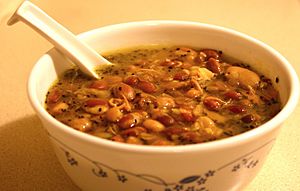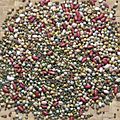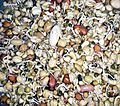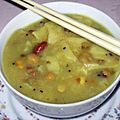Kwati (soup) facts for kids

A bowl of kwati
|
|
| Alternative names | Gedagudi, Kwanti |
|---|---|
| Course | mixed soup |
| Main ingredients | black gram, green gram, chickpea, field bean, soybean, field pea, garden pea, cowpea and rice bean |
Kwati is a special mixed soup from Nepal. It is made from nine different types of sprouted beans. In the Newari language, Kwati means "hot soup." It is a very old and traditional dish.
People in Nepal, especially the Newari community, eat Kwati during a festival called Guni Punhi. This festival happens on the full moon day of Gunlā, which is a month in their old calendar. It usually takes place in August. In some other parts of Nepal, like the Mithila Region, it is also known as Gedagudi.
Why Kwati is Special
Kwati is not just tasty; it is also very healthy! People eat it because it is good for them and has a special meaning.
This soup is known to help you feel better if you have a cold or a cough. It is also thought to be especially good for pregnant women. Since Kwati is made from many kinds of beans, it has lots of protein. Protein helps sick or weak people get their energy back.
The Guni Punhi festival, when Kwati is eaten, happens at the same time as another Hindu festival called Janāi Purnimā. This day is also known as Raksha Bandhan, a festival of sacred threads.
How Kwati is Made
To make Kwati, nine different kinds of beans are used. The most common beans are:
- black gram
- green gram
- chickpea
- field bean
- soybean
- field pea
- garden pea
- cowpea
- rice bean
First, the beans are soaked in water for about three to four days. This soaking makes them sprout, which means tiny shoots start to grow from them. After they have sprouted, the beans are boiled with different spices to make a thick soup.
A special seasoning is added at the end. This is made by heating Ajwain seeds in oil and then adding them to the soup. Sometimes, people even boil small squares of Flatbread with the Kwati to make it even more interesting!
Gallery





